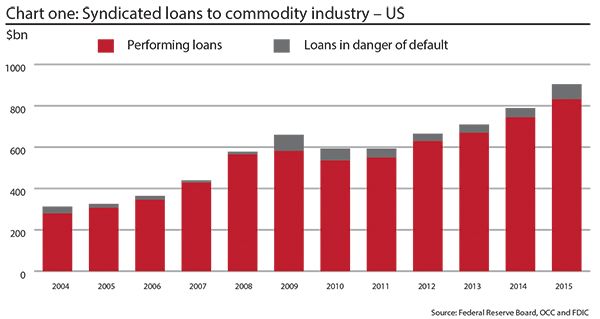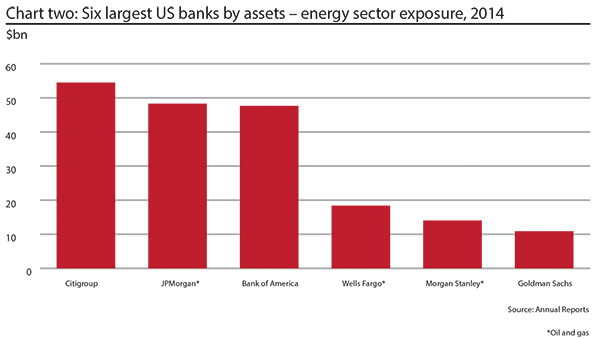The US commodities industry attracted more syndicated lending than nearly any other business in 2014. It also saw the largest rise in bad loans.
Data from a joint report by US financial regulators on syndicated lending shows a significant and potentially worrying increase in non-performing loans to the energy business, soaring $28.6bn to $72.1bn over the past year, nearly a 66% increase (see chart one).
The Shared National Credits Review pins the blame for problematic loans on oil and gas sectors, where commitments now stand at $276.5bn, or 30.6% of the total energy loans portfolio. Of these loans, $34.2bn is in danger of default, compared with $6.9bn in 2014.
Over the past decade, the commodity industry has been accumulating leverage at a breakneck speed. In 2007, syndicated lending to commodities ranked behind lending to the financial sector. It outpaced it a year after and has more than doubled since, with the total being $904.5bn this year.
Despite the commodity woes worldwide, syndicated lending made out to energy firms grew as quickly as ever, by $115.9bn over the past year.
The only industry that has higher leverage is services, at $1060bn, but even this sector cannot match commodities for growth.
Energy lending at major banks
Of the largest US banks, Citigroup had the biggest credit exposure to energy at the end of 2014 – $54.5bn, amounting to 10% of the bank’s corporate exposures (see chart two). This is a slight increase from 2013, when the bank had $52.9bn of exposure to the energy sector. According to the bank the energy portfolio is high-quality; about 85% of the exposures were rated investment grade.
The second largest exposure can be found at JPMorgan, although the bank is more diversified than Citi. The bank reported a $48.32bn oil and gas exposure in 2014, which makes for 5.3% of the bank’s credit exposures. As in the case of Citi, it saw its exposure to the sector inch up in 2014 by $1.4bn. However, its portfolio is not as solid as Citi’s – the bank reported that 69% of the debt was investment grade.
Bank of America reports a $47.67bn exposure in energy, having increased this figure throughout 2014 by $6.5bn, more than the two other banks. This expansion was primarily made on the back of oil and gas refining and marketing, exploration and production, and equipment and services sectors.
Beyond the big three, exposures are more modest. Wells Fargo has a $18.4bn exposure to the oil and gas sector, amounting to 6.5% of its total corporate exposure. The bank claims that half of these loans are made out to the exploration and production sector, and are secured by oil or gas reserves.
At $14.06bn, Morgan Stanley’s exposure to turmoil in the commodity market might seem smaller compared with its larger peers, but given the bank’s smaller corporate loan portfolio, commodities actually amount to 14.34% of its total exposures. Moreover, exposure at the bank rose nearly $2bn from the year before.
Goldman Sachs can boast the smallest exposure to energy compared with its peers. The bank has a $10.9bn exposure, of which $5.1bn is non-investment grade.




